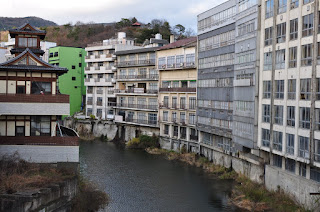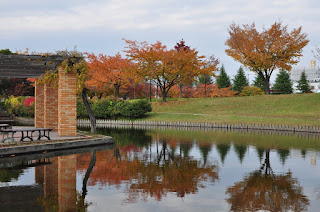




Yesterday, I went to a town called Iizaka. It neighbors
I moseyed on down to the station. It was a freezing miserable day, but at least it wasn’t raining. When I arrived, I saw the other piece of common knowledge spread about Iizaka: it’s train service. The Iizaka train is famous in
I neared the ticket area. Usually, there is vending type machine with locations and prices. Put in your money, push the button and a ticket will appear. Not so. I looked around with the “hey, gaijin here, someone tell me what to do” face. It worked flawlessly and a man I assumed to be the ticket collector beckoned me over. I told him in astoundingly flawless Japanese that I was making my way, or trying, to Iizaka. He looked to his watch and pointed. He pointed to a train off in the distance along the platform. Sensing some sort of time urgency I made my way through the turnstile, and toward the train. I still didn’t have a ticket.
As I boarded, I noticed the 200 year old lady in front of me push a button to open the door. A few people were in front of me, and I was the last to board. After I got on I noticed the same button inside the train. The slowly turning gears in my brain alerted me that this was some type of open and close button. I didn’t want to bother with it, so I took my seat. I figured that the door would close on it’s own after a few seconds. Nope. The freezing cold wind was blowing in the train and everyone was pissed off. Eventually an old man stood up with a “hmmmpf” and closed the door. He looked at me. I looked at him. If he was an American, he would’ve flipped me off. But, this is
As I sat, waiting to depart I realized that there was absolutely no time urgency what-so-ever. The ticket collector must have assumed that like most people boarding the train, I would require approximately 15 minutes to walk the 30 feet from the turnstile to the train. I wondered why he had pointed at his watch. Why didn’t he let me buy a ticket? Why was the train he pointed to under a sign marked to a different city? I was really starting to miss the efficiency, ease, and professionalism of the JR trains as opposed to this privately owned abomination. A JR train would never have a door button.
Anyway, we were off. The train was almost empty. There were a few old people, and an occasional school girl. It got me thinking: why were there so many more school girls than boys? This train had a maybe ten girls (the train only had three cars so I could see beginning to end no problem) in uniform, on a Sunday nonetheless, and not one boy. I started to wonder even more: were there really that many more school girls than boys? Did I just not see the boys because they didn’t wear tiny skirts in the middle of winter? Was it the socks? My mind started to wander. I snapped out of it by staring at an old lady who was staring at me. Her frigid stare and strange amalgam of winter clothing brought me back from my uniform induced stupor.
After about 10 stops, or about 30 minutes, I realized that I should have arrived in Iizaka already. I whipped out my handy dandy iPhone and checked my GPS. Lo and behold, I was a farther from Iizaka than when I had started. I was passing a “town” called Takako, which is basically the Japanese equivalent of naming a town Eleanor, or Beatrice, or some other antiquated name. I got off at the next stop. I was in the middle of nowhere. The sky was absolutely massive and clouds dotted out the sun. The wind was whipping and the groves of apple trees surrounding me were dancing in unison. I didn’t care about Iizaka. I could’ve stood at that train “station” for an hour absorbing the view. Luckily, the next train back to
I hopped on the train, found the stupid door button and settled in for the ride. Once again, old ladies with prying eyes, sleeping old men and motionless school girls surrounded me. On the return journey, I thought back to the ticket collector at the turnstile. Was that guy purposely screwing with me? Not only did he give me a clear indication of time urgency, but he pointed directly to the wrong train. I daydreamed about slapping him with my glove and challenging him to pistols at dawn. At least I got to see Takako and her beautiful view.
Once I arrived back in
I was off. The real Iizaka train was definitely all it was hyped up to be. It was bumpy, it stopped every 11 feet, it was cold, and the loudspeaker announcing the next station was too loud, yet somehow still incomprehensible. I put my chin on my chest and closed my eyes.
Once I arrived in Iizaka, I was happy. The city was small (less than 24,000), the sky was massive and beautiful, and the river running through the city was a nice refrain from the noise of
I wandered around in the downtown and eventually found a little park type thing with a place to dip my feet in some hot water. I walked to the main house area to see if I could rent a towel. It was free. I liked Iizaka even more, instantly. I soaked my feet in some scalding hot water as other old people and a few couples did the same. The same old ladies with the frigid stares and strange clothes now smiled at me and bowed. The power of something as simple as hot water was amazing.
With my feet nice and boiled, I dried off and slid my boots back on. I wanted to find the real hot spring. The pleasure of the hot water on my feet made me want to soak my entire body. I was not prepared for such a venture, but I figured I could at least find the bathhouse and come back next weekend. I walked around, through a nice temple and a graveyard and eventually found a big wooden building with a steaming tank raised high next to it. This had to be it. I was curious to see the inside of such a structure and also see what type of amenities they offered. Maybe I could rent a towel and whatever I else I needed. I walked over to the sliding doors. The doors were marked with the kanji for men and women, separately. You know what that means: naked time. I slid open the door and saw a small entrance area with a place to remove shoes. There was another sliding door inside and someone was coming out of it. I peeked in. I’m not really sure what I expected, but there was a bunch of naked dudes and steam. Everyone was old.
I ran. I ran all the way back to the train station, back to my house and into my bathroom. I filled my bath tub and threw in some bath salt. I drank a beer and read a book, and I didn’t have to see any naked dudes. Afterward, I lay in my bed until my hot water induced fever dissipated, slowly drifting off to sleep. It was fantastic. I can see how a public bathhouse would be enjoyable, if it was the year 1450. I think I will stick to my bathtub at home, though. No body minds if I drink beer, fart, or drop my book in the water. Nobody minds if I forget to push the button on the door. And, best of all, there are no ticket collectors on the way to my bathroom.
































